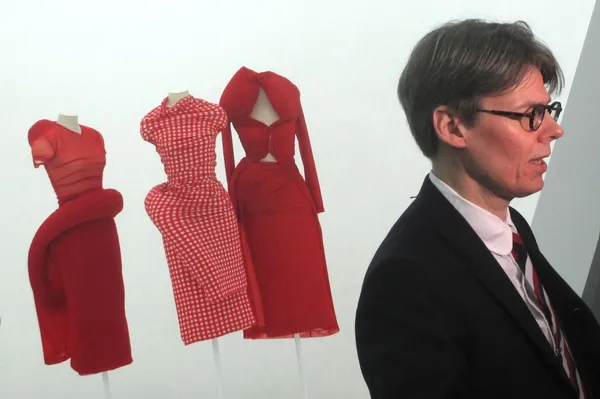 |
| Andrew Bolton in front of Body Meets Dress - Dress Meets Body on Rei Kawakubo and collaboration: "I think with Merce Cunningham, they both share notions of chance." Photo: Anne-Katrin Titze |
Andrew Rossi's The First Monday In May (2016 Tribeca Film Festival Opening Night Gala selection) brilliantly captured the work behind the scenes for The Metropolitan Museum of Art’s Costume Institute China: Through The Looking Glass exhibition, curated by Andrew Bolton with The Grandmaster's Wong Kar Wai as Artistic Director, and Vogue Editor-in-Chief Anna Wintour's Costume Institute Gala Benefit. The first Monday in May is here again.
 |
| Object/Subject - Rei Kawakubo/Comme des Garçons: Art Of The In-Between Photo: Anne-Katrin Titze |
Julianne Moore, Lena Dunham (seen at Tribeca in Laurie Simmons' My Art), Felicity Jones, Claire Foy, Ruth Negga, Lupita Nyong'o, Reese Witherspoon, Katie Holmes, Sarah Paulson, Madonna, Jeff Koons (Pappi Corsicato's Julian Schnabel: A Private Portrait, Barry Avrich's Blurred Lines: Inside the Art World), Cara Delevingne, Gwyneth Paltrow, Riley Keough, Blake Lively, Ryan Reynolds, Kerry Washington, Jennifer Lopez, Valentino, Naomi Campbell, Edward Enninful, Celine Dion, Rihanna, Rita Ora, Priyanka Chopra, Gigi Hadid, Mary-Kate Olsen and Ashley Olsen were among those on the red carpet leading up the steps of The Met last night for Anna Wintour's Costume Institute Rei Kawakubo/Comme Des Garçons: Art Of The In-Between Gala Benefit, co-chaired by Katy Perry, Pharrell Williams, Gisele Bündchen, and Tom Brady.
Andrew Bolton, Curator in Charge of The Costume Institute, took the time to talk with me about the moving images in the exhibit, museum as playground, and what Freud has to do with it all.
Anne-Katrin Titze: Right behind us is Rei Kawakubo's Merce Cunningham collaboration. You show it [Scenario, which premiered at BAM] on two monitors. Were you always clear that you wanted to include this [filmed] collaboration?
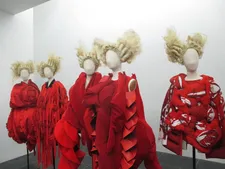 |
| War/Peace - Rei Kawakubo/Comme des Garçons: Art of the In-Between Photo: Anne-Katrin Titze |
Andrew Bolton: Very much, yes. We knew. Originally, we wanted to actually include the garments. The light levels are too high to show the museum objects. But I wanted to show … You know, Rei loves collaboration. She always says one plus one equals three. That once you collaborate with somebody, you get something else. It makes no sense if you collaborate with somebody and you get the end result. I think with Merce Cunningham, they both share notions of chance. I think that's one of the main things they share.
He had approached her before apparently to collaborate on a dance. And she sort of said, she didn't want to because she knew nothing about dance. And when she's worked on this particular collection [Body Meets Dress - Dress Meets Body], she could sort of see them on dancers. So she spoke to Merce and ended up with this Scenario in 1997 which was the only time she collaborated with Merce.
AKT: It's great you put it under the category Object/Subject. She is in this case also the object of his piece.
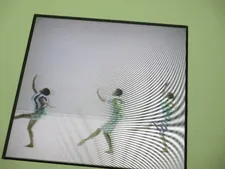 |
| Merce Cunningham - Scenario collaboration with Rei Kawakubo Photo: Anne-Katrin Titze |
AB: Absolutely, yeah. And vice versa.
AKT: The In-Between - your title is the Art Of The In-Between - I believe Freud said at some point that the In-between spaces belong to children. There is some of that in the architecture of the exhibition. As I was walking through, I thought that as a child I would have wanted to play in it.
AB: Yes!
AKT: In-between spaces don't belong to anyone. Is there a connection for you?
AB: 100%. It's interesting you brought up Freud because I do think Rei is in this sort of arrested development in a way. She always sees and she wants to see the world through the eyes of a child. Because she feels as if there's a sort of newness and originality through the eyes of a child or an outsider artist.
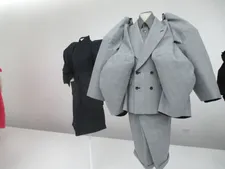 |
| Male/Female - Rei Kawakubo/Comme des Garçons: Art Of The In-Between Photo: Anne-Katrin Titze |
So the fact that there's the in-betweenness as a sort of precinct in a way of a child is very accurate. It's exactly how she would like to operate. I think also the space is playful. People find Rei a very, very serious designer - and she is. But she is also incredibly playful.
AKT: Her fondness of the Peter Pan collars [which both Andrew and I are sporting during this conversation].
AB: The collars, yeah. It's a very childlike aspect of clothes, yeah.
AKT: The War/Peace segment has some astonishing pieces. At first I couldn't put it together [the garments with the title] - the red quilted dresses. And then I read in your accompanying booklet the reference to Blood and Roses. Not having a description or any text next to it is a part of the experience. I came up with a completely different scenario [that included Brecht's Mother Courage and peaceful sleep in a quilted bed].
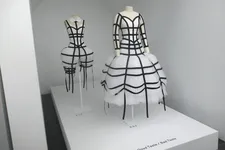 |
| Good Taste/Bad Taste - Rei Kawakubo/Comme des Garçons: Art Of The In-Between Photo: Anne-Katrin Titze |
AB: That's so nice. That's what we're hoping, aiming for. You know, Rei doesn't like to explain her clothes and I provided a curatorial interpretation, that is my interpretation. Flowers, as you know, is a recurring symbol in her work. But we deliberately didn't want to have text in the exhibition. It is in the brochure you can take away. So you can actually look at the clothes and create your own narratives, create your subjective analysis.
And if you so wish, you can look at the interpretation. Look at the title she has given it and how the curator sort of explained it. But I think it's important that when you first see it, you're confronted with your own reaction and your own sort of relationship to the object. And then if you want to, you can find out more about it.
AKT: Thank you. It is really beautiful.
At the press preview yesterday morning, Met Director Thomas P. Campbell and Caroline Kennedy, former United States Ambassador to Japan, followed by Andrew Bolton greeted the media. "The potential of fashion is limitless" and Rei Kawakubo shows us that, Bolton remarked. He references the Zen koans of mu (emptiness) and ma (space), the co-existing riddles that inspired the structure of the spectacular exhibit.
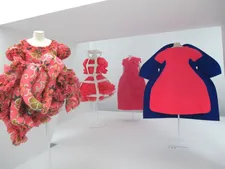 |
| Child/Adult - Rei Kawakubo/Comme des Garçons: Art Of The In-Between Photo: Anne-Katrin Titze |
As I toured the exhibition I encountered garments arranged in nine evocative clusters: Absence/Presence, Design/Not Design, Fashion/Antifashion, Model/Multiple, Then/Now, High/Low, Self/Other, Object/Subject, and Clothes/Not Clothes that challenge our thinking in relation to the body in the world.
The layout of the show highlights the in-between spaces, those we are particularly attracted to as children or as adults who haven't lost a sense of curiosity, humor and adventure - a closet underneath the stairs, a hidden corner in the attic, a treehouse, a half obscured room behind another. The playroom aura is juxtaposed with dazzling bright white walls and democratic lighting. The result is startling. It looks like nothing else The Met has done before.
There is no text on the walls besides the categories. Visitors are invited to enter into a personal dialogue and think about the dualisms addressed by Kawakubo's designs, why these binary systems exist in the first place, and how the structures are being reinforced every day, simply by getting ready to go out.
 |
| Form/Function - All heads and wigs by Julien d'Ys in Rei Kawakubo/Comme des Garçons: Art Of The In-Between |
Background on the individual pieces can be found in the accompanying brochure, which I recommend not to look at before experiencing a first round through the exhibition. You might want to have another go-round after reading Bolton's enlightening and focused commentary.
Why has the world of the internet with its infinite visuals produced so much uniformity in dress? Why is it that Rei Kawakubo - only the second living designer to be honored with a solo exhibit at The Met Costume Institute after Yves Saint Laurent in 1983 - is still such an exception of inspiration?
Her unfinished or worn-to death pieces allude to the Zen principle of wabi-sabi, whereas padding in unexpected places produces spectacular non-conformist results in cheerful gingham. What are these things that we put on ourselves each morning to face the world? What is their relation to the body? Here barriers dissolve and the freedom of the space takes over if you let it. The padded red cocoon without arms is more appealing than a tight dress or poor fitting jeans with knee rips.
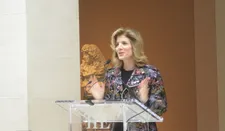 |
| Caroline Kennedy celebrates Rei Kawakubo at the press preview Photo: Anne-Katrin Titze |
Monsters, roses, the power of Lilith or a Blue Witch, the mind experiment of an 18th Century Punk made flesh (or cloth), and a Motorbike Ballerina - Kawakubo's collections transcend the limitations often placed on fashion. The objective here is clearly not a flight into fantasy dream worlds. Quite the opposite. The flight is into the Real because much of the consumerist fantasy has turned stale, limiting, antiseptic and a lie. The chapter on Self/Other epitomizes the in-between-ness on three levels. The labels East/West, Male/Female and Child/Adult are restraints set free here.
Bolton in two subsections of Then/Now, confronts the concept of time as in Past/Present/Future and the designer's ambivalent approach to history. The second half of this section, titled Birth/Marriage/Death, which includes dresses from the illuminating Broken Bride collection of autumn/winter 2005/06 takes the rituals out of the obscurity of nostalgia through doubt.
The last section, the exhibit's ninth life, Clothes/Not Clothes divided in seven subdivisions, marks also a new beginning. Bolton calls it the "second rupture" in Rei Kawakubo's career which took place in 2014. The first time the designer decided to start anew and change the direction of her work was in 1979.
The Metropolitan Museum of Art’s Costume Institute exhibition Rei Kawakubo/Comme des Garçons: Art Of The In-Between opens to the public on May 4 and is on view through September 4, 2017.





















